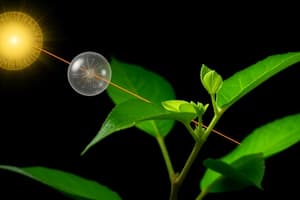Podcast
Questions and Answers
What is involved in identifying dark reactions?
What is involved in identifying dark reactions?
- 2D chromatography prevents separation of intermediates
- Rapid ‘quench’ (hydrochloric acid) to stop reactions
- Slow $CO_2$ injection
- Rapid $CO_2$ injection (correct)
What is the primary purpose of rapidly quenching a Chlorella suspension with perchloric acid during a $^{14}$CO$_{2}$ injection experiment?
What is the primary purpose of rapidly quenching a Chlorella suspension with perchloric acid during a $^{14}$CO$_{2}$ injection experiment?
- To immediately stop all metabolic reactions. (correct)
- To neutralize the pH of the suspension.
- To enhance the uptake of $^{14}$CO$_{2}$ by the *Chlorella* cells.
- To precipitate proteins for easier separation.
What is the main purpose of using 2D chromatography in pulse-chase analysis of the C3 cycle?
What is the main purpose of using 2D chromatography in pulse-chase analysis of the C3 cycle?
- To enhance the detection of $^{14}$C labeled compounds.
- To increase the speed of carbon fixation.
- To reduce the amount of sample required for analysis.
- To improve the separation of metabolic intermediates. (correct)
Why is the time sequence of product $^{14}$C labeling important in studying photosynthesis?
Why is the time sequence of product $^{14}$C labeling important in studying photosynthesis?
What is the primary function of RuBisCO?
What is the primary function of RuBisCO?
Which of the following statements about RuBisCO is NOT correct?
Which of the following statements about RuBisCO is NOT correct?
What is the primary outcome of the oxygenation reaction catalyzed by RuBisCO, which competes with carboxylation?
What is the primary outcome of the oxygenation reaction catalyzed by RuBisCO, which competes with carboxylation?
Which of the following is a function of photorespiration?
Which of the following is a function of photorespiration?
What is the main purpose of carboxysomes in cyanobacteria?
What is the main purpose of carboxysomes in cyanobacteria?
How do cyanobacteria accumulate CO$_{2}$ inside carboxysomes?
How do cyanobacteria accumulate CO$_{2}$ inside carboxysomes?
What is the primary function of pyrenoids in some algae?
What is the primary function of pyrenoids in some algae?
Which of the following is NOT involved in C4 photosynthesis?
Which of the following is NOT involved in C4 photosynthesis?
What is the main benefit of C4 photosynthesis compared to C3 photosynthesis?
What is the main benefit of C4 photosynthesis compared to C3 photosynthesis?
What is the main difference between C4 and CAM photosynthesis?
What is the main difference between C4 and CAM photosynthesis?
How do CAM plants conserve water?
How do CAM plants conserve water?
What is the approximate percentage of RuBisCO turnover that occurs through photorespiration in C3 plants?
What is the approximate percentage of RuBisCO turnover that occurs through photorespiration in C3 plants?
Flashcards
Dark Reactions
Dark Reactions
Biochemical processes in photosynthesis that do not require light, where carbon is fixed into sugars.
Carbon Fixation
Carbon Fixation
The process of converting inorganic carbon (CO2) into organic compounds, primarily sugars.
RuBisCO
RuBisCO
An enzyme that catalyzes the first step of carbon fixation in the dark reactions.
Photorespiration
Photorespiration
Signup and view all the flashcards
C4 Photosynthesis
C4 Photosynthesis
Signup and view all the flashcards
Fast CO2 injection
Fast CO2 injection
Signup and view all the flashcards
14C pulse-chase analysis
14C pulse-chase analysis
Signup and view all the flashcards
Light and dark reactions
Light and dark reactions
Signup and view all the flashcards
Calvin-Benson cycle
Calvin-Benson cycle
Signup and view all the flashcards
Carboxysomes
Carboxysomes
Signup and view all the flashcards
Pyrenoids
Pyrenoids
Signup and view all the flashcards
Hatch-Slack pathway
Hatch-Slack pathway
Signup and view all the flashcards
Diel cycle
Diel cycle
Signup and view all the flashcards
Efficiency of C3 cycle
Efficiency of C3 cycle
Signup and view all the flashcards
Nobel Prize in Chemistry 1948
Nobel Prize in Chemistry 1948
Signup and view all the flashcards
RuBisCO subunits
RuBisCO subunits
Signup and view all the flashcards
Study Notes
Summer Break Research Opportunities
- Students can participate in hands-on research during the summer break.
- Opportunity to work with professors at the University of Glasgow's Institute of Molecular, Cellular, and Systems Biology and the Plant Science Research Group.
- £1000 bursary and 4-8 weeks research experience available.
- Consult a faculty member, agree on a project, and submit a project proposal to the Undergraduate School.
- Open to first-year undergraduate students in the natural sciences and related disciplines.
- Details available on the MOODLE site or contact Prof. M. Blatt ([email protected]).
- Submission deadline: 12:00 noon Friday, March 20, 2020.
Photosynthesis - Dark Reactions
- What are the 'dark' reactions?
- How is carbon captured and fixed into sugar?
- What is RuBisCO?
- What is photorespiration?
- What is C4 photosynthesis?
How Were Dark Reactions Identified?
- Fast CO2 injection.
- Rapid 'quench' (perchloric acid) to halt reactions.
- Two-dimensional chromatography improves the separation of intermediates.
Carbon-14 Pulse-Chase Analysis of the C3 Cycle
- Two-dimensional chromatography improves separation of intermediates.
- 5-second and 30-second labeling of photosynthetic products with carbon-14 to track the sequence of events.
Photosynthesis Divided into Light and Dark Reactions
- The Calvin-Benson cycle was identified in 1948 and led to a Nobel Prize.
- The cycle shows the sequence of products being labeled with carbon-14, indicating the sequence of conversions.
- Key enzyme is RuBisCO (Ribulose-bisphosphate carboxylase/oxygenase).
Light and Dark Reactions
- Gaseous CO2 and the 5-carbon sugar (ribulose 1,5-bisphosphate) combine to form two molecules of 3-phosphoglycerate (PGA).
- The reaction is not reversible.
- RuBisCO accounts for ~50% of plant leaf soluble protein.
- RuBisCO has 8 large subunits (nuclear-encoded) and 8 small subunits (chloroplast-encoded).
Chlorophyll Capturing Light
- RuBisCO also catalyzes the competing oxygenation reaction using O2 instead of CO2.
- The oxygenation reaction causes photorespiration which recycles and consumes ATP and NADH, releasing glycine, serine, and CO2.
Alternative Photosynthetic Strategies
- Cyanobacteria contain Carboxysomes to concentrate CO2 around RuBisCO.
- Some algae concentrate CO2 around RuBisCO through pyrenoids.
- Some angiosperms employ C4 or CAM photosynthesis to overcome limitations of RuBisCO.
CAM Photosynthesis
- CAM photosynthesis separates C4 and C3 fixation through time (night and day).
- CAM plants store C4 acids in the vacuole for decarboxylation and refixation by RuBisCO during the day.
- CAM uses an "inverted" stomatal cycle to conserve water and concentrate CO2 in the leaf.
CO2/O2 Limits C3 Cycle Efficiency
- In C3 plants, photorespiration accounts for ~30-50% of RuBisCO turnover.
Is CAM Better for Engineering?
- CAM requires engineering of 35-40 gene targets with their promoters.
- Dark reactions utilize NADPH and ATP to fix CO2 with RuBisCO.
- C3 process is limited by CO2 versus O2 selectivity.
- C4 and CAM overcome this limitation by introducing a 'pre-fixation step' before using RuBisCO to capture CO2 as a four-carbon acid.
Studying That Suits You
Use AI to generate personalized quizzes and flashcards to suit your learning preferences.



